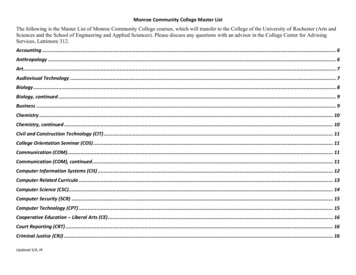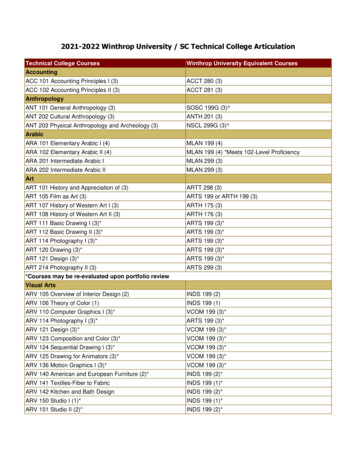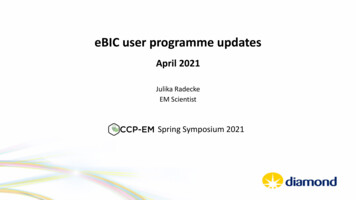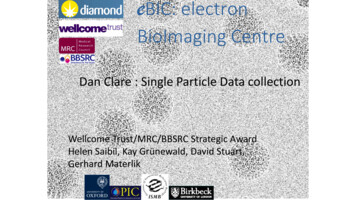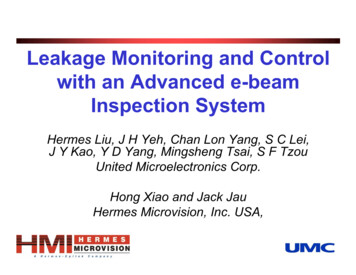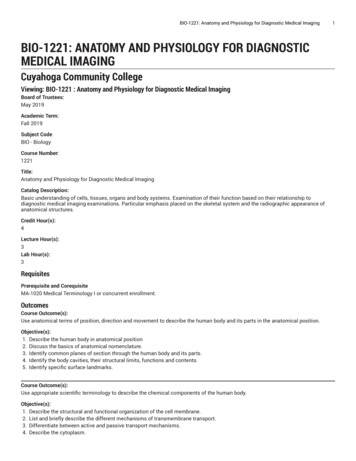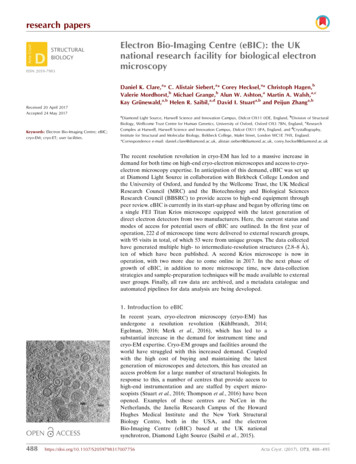
Transcription
research papersISSN 2059-7983Electron Bio-Imaging Centre (eBIC): the UKnational research facility for biological electronmicroscopyDaniel K. Clare,a* C. Alistair Siebert,a* Corey Hecksel,a* Christoph Hagen,bValerie Mordhorst,b Michael Grange,b Alun W. Ashton,a Martin A. Walsh,a,cKay Grünewald,a,b Helen R. Saibil,a,d David I. Stuarta,b and Peijun Zhanga,bReceived 20 April 2017Accepted 24 May 2017aKeywords: Electron Bio-Imaging Centre; eBIC;cryo-EM; cryo-ET; user facilities.Diamond Light Source, Harwell Science and Innovation Campus, Didcot OX11 0DE, England, bDivision of StructuralBiology, Wellcome Trust Centre for Human Genetics, University of Oxford, Oxford OX3 7BN, England, cResearchComplex at Harwell, Harwell Science and Innovation Campus, Didcot OX11 0FA, England, and dCrystallography,Institute for Structural and Molecular Biology, Birkbeck College, Malet Street, London WC1E 7HX, England.*Correspondence e-mail: daniel.clare@diamond.ac.uk, alistair.siebert@diamond.ac.uk, corey.hecksel@diamond.ac.ukThe recent resolution revolution in cryo-EM has led to a massive increase indemand for both time on high-end cryo-electron microscopes and access to cryoelectron microscopy expertise. In anticipation of this demand, eBIC was set upat Diamond Light Source in collaboration with Birkbeck College London andthe University of Oxford, and funded by the Wellcome Trust, the UK MedicalResearch Council (MRC) and the Biotechnology and Biological SciencesResearch Council (BBSRC) to provide access to high-end equipment throughpeer review. eBIC is currently in its start-up phase and began by offering time ona single FEI Titan Krios microscope equipped with the latest generation ofdirect electron detectors from two manufacturers. Here, the current status andmodes of access for potential users of eBIC are outlined. In the first year ofoperation, 222 d of microscope time were delivered to external research groups,with 95 visits in total, of which 53 were from unique groups. The data collectedhave generated multiple high- to intermediate-resolution structures (2.8–8 Å),ten of which have been published. A second Krios microscope is now inoperation, with two more due to come online in 2017. In the next phase ofgrowth of eBIC, in addition to more microscope time, new data-collectionstrategies and sample-preparation techniques will be made available to externaluser groups. Finally, all raw data are archived, and a metadata catalogue andautomated pipelines for data analysis are being developed.1. Introduction to eBICIn recent years, cryo-electron microscopy (cryo-EM) hasundergone a resolution revolution (Kühlbrandt, 2014;Egelman, 2016; Merk et al., 2016), which has led to asubstantial increase in the demand for instrument time andcryo-EM expertise. Cryo-EM groups and facilities around theworld have struggled with this increased demand. Coupledwith the high cost of buying and maintaining the latestgeneration of microscopes and detectors, this has created anaccess problem for a large number of structural biologists. Inresponse to this, a number of centres that provide access tohigh-end instrumentation and are staffed by expert microscopists (Stuart et al., 2016; Thompson et al., 2016) have beenopened. Examples of these centres are NeCen in theNetherlands, the Janelia Research Campus of the HowardHughes Medical Institute and the New York StructuralBiology Centre, both in the USA, and the electronBio-Imaging Centre (eBIC) based at the UK nationalsynchrotron, Diamond Light Source (Saibil et al., Acta Cryst. (2017). D73, 488–495
research papersaim to provide a 48 h microscope session within six weeks ofthe application deadline. Rapid proposals which are unsuccessful owing to the oversubscription of available microscopetime are given feedback and may be put forward for the nextapplication round. BAG calls occur every six months andprovide a substantial amount of microscope time to an institute or a collection of users for a two-year period commencingsix months from the application deadline. BAGs are reviewedevery six months, allowing the amount of time allocated andthe number of users on the proposal to be altered. This modelis based on one first devised by the the European SynchrotronRadiation Facility (ESRF) and now successfully used formacromolecular crystallography beamlines around the worldas it provides user-driven flexible access. A typical eBICsession consists of 48 h of instrument time. Time offered viathese first two routes comes with travel and subsistence forUK users. For European Union (EU) users travel andsubsistence may be currently covered via iNext, which isfunded through the Horizon 2020 programme of the EuropeanUnion (http://www.inext-eu.org). The only stipulations for thepeer-reviewed access routes are that there must be an intention to publish the results and that eBIC/Diamond LightSource and the funders are acknowledged. The third mode ofinstrument access is paid, i.e. proprietary. A limited amount oftime is available via this route,which is administered by theindustrial liaison office atDiamond Light Source and doesnot require that the data bepublished.eBIC presently has two operational FEI Titan Krios microscopes (Krios I and II), both ofwhich are equipped with directelectron detectors (initially eachhas both an FEI Falcon II and aGatan K2 after a Gatan Quantumenergy filter). Krios II was onlyrecently added to the userprogram, so the results detailedbelow are from Krios I only. In itsfirst year of operation Krios Ihas over-delivered by 35% withregard to the number of externaluser days that it was projected toprovide, based on the synchrotron-beamline model of approximately 17 d of external user time.In addition to the two Kriosmicroscopes, eBIC will soon havetwo further microscopes: an FEITalos Arctica 200 keV TEM andan FEI Scios focused ion beamFigure 1Krios 1 usage. (a) A graph showing the total number of unique research groups from different locationsscanning electron microscopethat have used Krios 1 during the first year of eBIC. (b) The total number of hours for each of these(FIB-SEM). The most effectivelocations. London consists of multiple institutions, including Birbeck College, Imperial College, the Crickways of integrating theseInstititute and the Institute of Cancer Research. Cambridge consists of the University of Cambridge andmachines into the eBIC userthe MRC–LMB.The main aim of eBIC is to follow the synchrotron modeland provide, free at the point of use, access to state-of-the-artequipment used in biological cryo-EM based on peer review ofscientific merit and technical feasibility. Furthermore, eBICaims to help to drive the cryo-EM field forward through strongin-house research and development. In order to achieve bothof these goals, 80% of the available instrument time isprovided through the peer-review process, while 20% isreserved for commissioning and in-house research. Anotherimportant role for eBIC, which is already beginning to bedeveloped, is to build competence in the user communitythrough training courses and user sessions where eBIC staffprovide expertise in grid preparation and optimization. Theultimate aim is not only to enhance the capability of theexisting user base but also to make cryo-EM accessible tononspecialists.Time on the microscopes at eBIC is obtained via threedifferent routes: the first two routes are awarded via peerreviewed proposals and are called Rapid and Block AllocationGroup (BAG) access (http://www.diamond.ac.uk/Users.html).The peer-review panel consists of a number of UK-based cryoEM experts, and every proposal submitted to eBIC is reviewedand scored by at least three panel members. Rapid-access callstake place quarterly, require preliminary cryo-EM data andActa Cryst. (2017). D73, 488–495Clare et al. Electron Bio-Imaging Centre489
research papersprogramme are currently being established. In one model, theTalos will be available to less experienced cryo-EM users as aproject-development tool for the optimization of freezingconditions and initial data-set collection. However, we alsointend to explore the extent to which the Talos can be used toscreen grids before they are transferred to an eBIC Kriosmicroscope, and to perhaps establish a path to predeterminethe best data-collection points from overview maps andtransfer these maps, thereby maximizing time for datacollection on the high-end Krios instruments. The Sciosprovides the ability to selectively thin down thick samples(such as eukaryotic cells grown on EM grids) to produceslivers of material of a few hundred nanometres in thickness(termed lamellae; Marko et al., 2006; Schaffer et al., 2015). Thisprocess is quite time-consuming and so it is likely that, at leastin the first instance, access will be through specific calls aimedat enabling high-impact projects, for instance requiring theimaging of processes that occur in thicker regions of cells bycryo-electron tomography (cryo-ET).2. Results from the first year of eBICIn its first year of operation, from July 2015 to July 2016, KriosI delivered 222 d to the external user program. This comprised95 separate visits from 53 different investigators (Fig. 1). Eachvisit was either 48 or 72 h in duration, with the first 4–8 h usedfor sample loading, screening and instrument setup. Abreakdown of the time allocated shows that groups fromCambridge, London and Oxford were the largest users ofeBIC, which mirrors the distribution of cryo-EM groups in theUK. In addition, groups from both Manchester and Leeds,which also have strong cryo-EM communities, received asignificant percentage of the time allocated. At the time ofwriting of this paper, only Cambridge had direct access to anin-house Krios microscope. However, Cambridge also has thelargest in-house community of cryo-EM users. Cryo-EMgroups from several countries in continental Europe and theUSA have also collected data at eBIC.The majority of external user sessions at eBIC werecollected using the single-particle technique (91%), mainlyusing the Quantum K2 Summit detector (80%). The QuantumK2 was exclusively used for all external user tomographysessions, as the use of the energy filter is highly desirable forthicker specimens. The effective use of the Quantum K2detector was facilitated by engagement with the microscopemanufacturer (FEI), who agreed to integrate the Quantum K2with their automated single-particle data-collection software,EPU. This integration initially required a few weeks of Kriostime but has been broadly successful, although there is stillfurther work required, for instance to routinely use the Voltaphase plate (see below). An average 48 h session generatesapproximately 2 TB of data collected on the Falcon II detectorand about 2.9 TB of data collected on the Quantum K2Summit detector. These volumes of data arise because bothdetectors collect each projection image as a series of movieframes, and correspond to an average of around 2650 movieson the Falcon II and 2200 movies on the Quantum K2 Summit.490Clare et al. Electron Bio-Imaging CentreThe Falcon II collects movies at a somewhat faster rate thanthe Quantum K2 Summit, as the Falcon II is an integratingdetector whilst the Quantum K2 Summit is a counting detectorand therefore has a more modest upper limit on the rate atwhich electrons can be recorded, resulting in longer exposuretimes. Other factors also affect the data-collection rates, suchas the number of frames per movie, the hole size of the gridsused and the operation mode of the Quantum K2 Summit(counting versus super-resolution). The fastest rates achievedon the Quantum K2 and Falcon II, using equivalent grid typesand setups, were 65 and 75 images per hour, respectively.In total, in the first year of operation Krios I has generated270 TB of data. The data volumes and rates for eBIC are set toincrease with additional microscopes coming online and fasterdetectors; thus, we expect the data rate to exceed 1 PB peryear by the end of 2017. The large volume of data collectedhighlights another benefit of housing eBIC at a national centrewhich has the computing resources to handle the storage,transfer and archive of sizeable amounts of data. In practice,this means that as the data are collected on the microscopethey are written to Diamond’s central high-speed file system,and once there they are freely available to the user via FTP orGlobus FTP and are archived to tape almost immediately,where they will be stored for the lifetime of the tape mediaand will be available for recovery via a web interface. Thisremoves the burden of long-term data storage and backupfrom the host institute of the user. Diamond also has significant computational power (CPU and GPU) tightly coupled tothe high-speed file system, so that a significant amount of dataanalysis can be supported. Work is under way with the dataanalysis group at Diamond and with CCP-EM (Wood et al.,2015) to implement automated pipelines to provide real-timefeedback for both single-particle and tomography applications. Underpinning this work will be the effective integrationof experimental information management to facilitate dataprovenance as well as effective experiment tracking, monitoring and eventually integration with data from other disciplines. For this purpose, the ISPyB information-managementsystem (Delagenière et al., 2011) and its interfaces SynchWeb(Fisher et al., 2015) and SynchLink (Ginn et al., 2014), whichare already extensively used on macromolecular crystallography beamlines at Diamond, are being extended to encapsulate eBIC sample tracking as well as single-particle andtomography data collection and processing.The data collected at eBIC have, at the time of writing,generated ten research publications (Hospenthal et al., 2016;Serna et al., 2016; Joseph et al., 2016; Wilkinson et al., 2016;Iadanza et al., 2016; Ramsay et al., 2016; Fica et al., 2017; Swuecet al., 2017; Ilangovan et al., 2017; Boland et al., 2017). We havealso received a number of personal communications from inhouse and external users reporting reconstructions at betterthan 4 Å resolution, with a few extending beyond 3 Å. Thecollection of single-particle data sets is routine and if thesample is suitable and the grids are of sufficient quality thenhigh-resolution structures can be expected. The exception tothis is for protein complexes smaller than 150 kDa, wherethe phase plate may be needed.Acta Cryst. (2017). D73, 488–495
research papers3. Future challenges for eBICWe anticipate a number of challenges for eBIC and highlightthree here in particular.3.1. Working with the Volta phase plateOne of the main focuses of the in-house research at eBIChas been the incorporation of the phase plate for both singleparticle and cryo-ET applications. Without a phase plate, thecontrast of an image taken with a modest under-focus will,when Fourier transformed, resemble a sine function, so thatthere will be little contribution from the crucial low-resolutionterms. In comparison, with full phase contrast this functionbecomes akin to a cosine function, so that contrast is maximized for the low-resolution terms that are critical to locatingand orientating small objects in the image, potentiallyproviding a step change in capability. The phase platecurrently installed on the Titan Krios microscopes is of thehole-free Volta type (Danev et al., 2014). This phase plateworks via the generation of a charge potential on an amorphous carbon film, placed at the back focal plane of theobjective lens, that induces a phase shift of the unscatteredelectrons relative to the scattered electrons. The inducedphase shift changes over time, initially increasing rapidly overthe so-called conditioning period of the phase plate, followedby a slower increase generating a more stable phase shift.Typically, on our system, using a nominal magnification of81 000 in EFTEM mode at a dose rate of around 5 electronsper pixel per second (determined on the Quantum K2Summit), phase-plate conditioning takes around 5 min. Dataare then collected during the period of gradual increase inphase shift until the induced phase shift exceeds 90 . In arecent publication the phase plate was changed every hour(approximately 27 images) such that the phase shift did notincrease much beyond 90 (Danev & Baumeister, 2016).Both the conditioning time and the period of gradualincrease in phase shift can vary for a particular phase plate.The temperature at which the phase plate is maintained in themicroscope also has an effect on the characteristics of thephase plate, with higher temperatures increasing the conditioning time required to reach a particular phase shift (Danevet al., 2014). Another feature of the phase plate is that thequality of the Volta potential is very sensitive to surfacecontamination, such that there is no guarantee that any twopositions on the phase plate will generate equally high-qualityphase plates. The effect of this surface contamination canrange from mild objective astigmatism to a dramatic distortionof the image. These features make automated data collectionwith the phase plate more complicated than traditional defocused imaging. However, even with the increased overheadsFigure 2Non-phase-plate versus phase-plate data. A cryo-EM micrograph of FMDV taken at 1 mm defocus and its corresponding power spectrum (a, c) arecompared with a micrograph and its corresponding power spectrum when aquired in focus and using the Volta phase plate (b, d). The images were takenwith EPU at an equivalent total dose of around 30 e Å 2 at a pixel size of 1.06 Å per pixel using Krios 1 at eBIC. Images were collected on the QuantumK2 Summit detector in counting mode ( 6 electrons per pixel per second) with a 20 eV slit width. The FMDV virus particle can be clearly seen in thephase-plate image. The power spectra clearly show that the phase-plate image was in focus as there is no zero CTF present when compared with the 1 mmunder-focus power spectrum. The samples were prepared by A. Kotecha, E. E. Fry, J. Seago and D. I. Stuart. The power spectra were calculated usingBsoft (Heymann et al., 2008). The scale bar in (b) is 30 nm and the dashed rings in (c) and (d) are at 3.7 Å resolution.Acta Cryst. (2017). D73, 488–495Clare et al. Electron Bio-Imaging Centre491
research papersthat the phase plate brings, the large boost in low-resolutioncontrast, such that defocusing of the objective lens is no longerrequired, makes it not only advantageous for cryo-ET but alsofor proteins and complexes, especially those smaller than150 kDa in mass. The potential of the phase plate for smallerobjects is beautifully illustrated by the recent structure ofhaemoglobin, a 64 kDa protein complex, determined at 3.2 Åresolution (Khoshouei et al., 2016). In-focus imaging also hasthe benefit of removing the effects of the contrast-transferfunction of the objective lens, potentially making it easier tocollect images that are as close to optically perfect as iscurrently possible (Fig. 2; Danev & Baumeister, 2016).However, to achieve resolutions of better than 3 Å it isnecessary to set the sample focus to 60 nm from absolutefocus. The main issue with achieving this level of accuracy is indetermining the exact focus of the area of interest. A numberof factors make this difficult, in particular the off-area focusingrequired for low-dose imaging, specimen flatness and tilt.Accurate focus determination is further complicated by theeffect of the spherical aberration constant (Cs) of the objectivelens, with a recent paper reporting that for a Titan Kriosmicroscope a focus offset of 270 nm was required to accuratelyset the defocus value to zero. For example, to achieve 20 nmdefocus the microscope defocus must be set to 250 nm (Danev& Baumeister, 2016). This offset is not a constant and dependson the amount of beam tilt that is used for focus estimation. Inorder to obtain an accurate focus determination, it has beensuggested that for single-particle approaches the use of fourfocus positions around the area of interest is a superiorapproach to a single focus position. However, this method isvery time-consuming and significantly reduces the rate of datacollection. Recently, software has been developed that cantake the phase shift induced by the phase plate into accountduring defocus determination, such as CTFFIND4 and Gctf(Rohou & Grigorieff, 2015; Zhang, 2016), and contrasttransfer function (CTF) correction, such as RELION2(Scheres, 2012). These developments should assist withimaging of objects using a small amount of underfocus (e.g.0.5 mm) and for the correction for this underfocus in theacquired images.At the moment the phase plate is not fully integrated intoEPU and hence new phase plates cannot be generated automatically. The conditioning of new phase plates, approximately every hour, is essential as the phase shift induced bythe phase plate increases past 90 in a dose-dependent andtime-dependent manner and reduces the quality of the laterimages. One current solution for this involves the installationof an additional piece of software that moves to the next phaseplate at a designated time. For cryo-ET, this is incorporated inthe TOMO software from FEI, thus making fully automatedtomography data collection possible (Fig. 3). Incorporatingthe use of the phase plate into the user program is still a workFigure 3Phase-plate tomography of the perforin pre-pore complex. The 0 image from the tomogram (a), the central ten z sections averaged from thereconstructed tomogram (b) and an enlarged 20-z-section average from the reconstructed tomogram (c) of perforin pre-pores bound to liposomescollected with the phase plate. The tomogram was collected on Krios II at eBIC at 1.7 Å per pixel using the Quantum K2 detector in counting mode ( 5electrons per pixel per second) with a 20 eV slit width and a nominal defocus of 300 nm to avoid going over focus. Tilt images were collected from 45 to45 in 3 increments, giving a total dose of around 60 e Å 2. The tomogram was collected using the FEI TOMO package and was processed withMotionCorr and IMOD (Li et al., 2013; Kremer et al., 1996). The scale bars in (a) and (b) are 100 nm and the scale bar in (c) is 10 nm. The grids wereprepared by N. Lukoyanova.492Clare et al. Electron Bio-Imaging CentreActa Cryst. (2017). D73, 488–495
research papersin progress, but its potential for cryo-ET and small singleparticles will make it highly desirable for many of eBIC’s usergroups going forward. We encourage such users to contact theeBIC staff before submitting applications for microscope time.3.2. Sample preparation using FIB-SEMIdeally, biological complexes should be imaged in theirnative environment inside intact cells. However, TEMs arelimited in their penetration power, requiring samples to be lessthan 0.5–1 mm thick (Koster et al., 1997). Many groups havecoped with this limitation by studying purified biologicalcomplexes or thin regions of cells or by using a techniqueknown as cryo-electron microscopy of vitreous sections(CEMOVIS; Al-Amoudi et al., 2004). While many biologicalquestions can be answered using purified complexes, someinteractions, conformations and/or transitional states may notbe captured in vitro, and many biological complexes andinteractions are not present in the thin peripheral regions ofcells. While cryo-sectioning is a good alternative, this technique is technically challenging and generates artifacts suchas compression of the sample (Al-Amoudi et al., 2005). Theadvent of a cryo-capable FIB-SEM (focused ion beam scanning electron microscope), which uses a focused beam of ions(usually gallium) to ablate regions of the sample, has made itpossible to thin specific areas of vitrified samples for furtherimaging by cryo-EM (Marko et al., 2006; Wang et al., 2012;Rigort, Bäuerlein et al., 2012; Rigort & Plitzko, 2015; Fig. 4).This technique, coupled with the latest fluorescence cryoimaging techniques, can provide detailed views of biologicalprocesses over a wide range of resolution scales (Rigort, Villaet al., 2012; Wolff et al., 2016). Currently, only a small numberof laboratories around the world are equipped with cryo-FIBSEM machines, severely limiting the access of researchers tothis technique. At eBIC we will provide both a state-of-the-artinstrument (FEI Scios) and the expertise to use it. The userprogram should start during 2017, giving structural biologistsand cell biologists access to this technique using a proposalbased model. As this is currently not a high-throughputtechnique, only a limited number of collaborative projects willbe accepted initially. Success, impact on the community andrespective demand will be monitored closely and we encourage potential users to discuss their application with the eBICstaff. Eventually, the intention of eBIC is to offer FIB-SEMcoupled with correlative fluorescence microscopy and cryoET, providing users with all of the tools necessary to address awide range of biological questions spanning multiple resolution scales.3.3. Computational requirementeBIC already benefits greatly from the computationalinfrastructure at Diamond, expecially with regards to datamanagement facilities. If the traditional model is maintainedFigure 4Focused ion beam cryo-milling of herpesvirus-infected cells. Cryo-EM/ET of lamellae produced by focused ion beam (FIB) milling with the eBIC FEIScios dual-beam scanning electron microscope (SEM). (a) Screenshot of the FIB-SEM acquisition software shortly before milling a lamella into aplunge-frozen porcine kidney cell grown on electron-microscopy grids and infected for 10 h with herpesvirus PrV US3 (muliplicity of infection 10).Several imaging modalities support efficient milling, e.g. SEM for targeting an appropriate cell specimen (I), FIB imaging for planning and controllinglamella geometry (II), an in-column detector to provide material-specific contrast to check for a protective platinum coat on the sample (III) and aninfrared live camera to monitor the cryostage (IV). (b) FIB image of the completed lamella through the cell depicted in (a) as viewed from the millingangle (18 ). (c) The same lamella as in (b) imaged via SEM from the built-in angle of 52 between the electron and ion beams. A low electronacceleration voltage allows the observation of cellular details. (d) Low-magnification cryo-EM projection image at 0 of the lamella depicted in (b) and(c). Before milling, the leading edge was protected from erosion by the gallium ion beam by a platinum layer (black asterisk; ice contamination is shownby white asterisks). Denser objects in the cell led to curtaining (cytoplasmic lipid body; arrowhead). (e) Cryo-ET slice of a tomogram taken in the areamarked by a white square in (d), lamella thickness 130 nm. Visible within the nucleoplasm (nuc) are nucleocapids at different stages of maturation:spherical assemblies of scaffolding protein (1), procapsids (2), partly DNA-filled (3) and nuclear C-capsids (4), which subsequently bud intonucleoplasmic reticulum (NR) forming nuclear egress complex (arrow)-lined capsid-containing vesicles in the perinuclear space (5).Acta Cryst. (2017). D73, 488–495Clare et al. Electron Bio-Imaging Centre493
research papersof transferring all of the data to the user’s home laboratory forprocessing then the current Diamond processes are sufficient,although users will need significant computational and storageresources at their home institution. However, as noted above,we propose to provide close to real-time data-processingpipelines for both single-particle and tomography analysesand to explore the possibility of allowing post-processing ofthe data. Providing such options will require extensivecomputational resources. Although eBIC is well placed tobenefit and centralize these resources, the current softwareand data-analysis requirements for processing the data extendwell beyond the duration of the measurements. The hardwarerequirements needed for the processing have also changedmarkedly over the past 12 months as analysis packages such asRELION and cryoSPARC (Kimanius et al., 2016; Punjani etal., 2017) have provided major accelerations by extensiveadaptation to GPU architectures. Together, these developments pose a new challenge and are an area of intensivediscussion.4. ConclusionsIn the first year of operation eBIC has delivered free-at-thepoint-of-use access to high-end electron microscopy equipment to a large number of different researchers. The numberof publications currently stands at ten, but this will increase asthe data collected are processed and fully analysed. Withfurther Titan Krios microscopes coming online and the addition of the Talos and Scios instruments, the capacity willincrease and more modes of access will be provided. Crucial tofuture developments will be optimizing the efficient use of thehigh-end instruments, for example reducing the setup andscreening time on the Krios and maximizing data-collectiontime and data throughput. We will also explore different datacollection software so that we can maximize data throughputand potentially support new data-acquisition schemes. Thismeans that the amount of high-quality data generated at eBICwill significantly increase in the next few years. As well as anincrease in the number of microscopes, the incorporation ofautomated processing pipelines should improve the dataquality collected as users will be able to obtain real-timefeedback, much like a traditional macromolecular crystallography beamline at Diamond.AcknowledgementsWe thank FEI, and in particular the application support team,for help with the initial running and for continued support ofeBIC. We also thank the in-house groups for providingsamples for development of the phase plate for both cryo-ETand single-particle analysis. We would also like to highlight thecontribution of the Baumeister group (MPI Biochemistry,Martinsried, Germany), in particular Mirosl
UK. In addition, groups from both Manchester and Leeds, which also have strong cryo-EM communities, received a significant percentage of the time allocated. At the time of writing of this paper, only Cambridge had direct access to an in-house Krios microscope. However, Cambridge also has the largest in-house community of cryo-EM users. Cryo-EM
